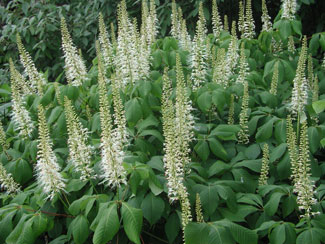Resource Library
Plant of the Week: Bottlebrush Buckeye
The University of Arkansas System Division of Agriculture does not promote, support or recommend plants featured in "Plant of the Week." Please consult your local Extension office for plants suitable for your region.
Plant of the Week
Bottlebrush Buckeye
Latin: Aesculus parviflora

It is a well reported that many American native shrubs are more commonly seen in European gardens than in American. This desire for something exotic and different is probably a part of human nature even though it seems to make little sense, but who ever said fashion was sensible? Bottlebrush buckeye (Aesculus parviflora), for example, became an instant success when introduced to the Old World by John Fraser (1750 – 1811) though it is still relatively uncommon in our own gardens.
Bottlebrush buckeye is one of about 18 species of buckeyes found in North America and Euro-Asia of which six are native in the New World. This species is native to a large swath of central Alabama and a small region of west-central Georgia though it is hardy as far north as Maine. Like many southeastern native shrubs it probably once occurred over a greater area of eastern North America until being forced south during periods of glaciations over the past million years.
Bottlebrush buckeye is a deciduous, stoloniferous shrub that typically grows about 8 feet tall and twice as wide, but given enough time can get even bigger. It has many upright slender branches that produce a mass of saucer-sized compound leaves with five to seven elongate leaflets emerging individually from a 4-inch long petiole. Leaves are a good clean green in summer and turn yellow in the fall. Overall, the shrub has a broad spreading form that can best be described as stately.
In June the plant produces a profusion of erect, pointed, bottlebrush shaped white flowers that range from 8 to 18 inches long. The flowers are held above the foliage and remind me of candles on a birthday cake. Individual flowers are four-petaled with inch long pinkish stamens. The species epitaph translates as “many small flowers”, an apt name for a shrub that has no serious rivals in beauty during its blooming period. Two-inch long, smooth, tan colored pear-shaped capsules produce the large mahogany colored seeds which are released in early October.
Bottlebrush buckeye was first collected by the Philadelphia naturalist and nurseryman William Bartram during his well recorded southern travels during the 1770s. But the species’ introduction to England did not occur until 1785 when John Fraser collected material from its native range. Fraser made seven collecting trips to eastern North America and Cuba from 1785 until 1810. He and a brother established a nursery in Charleston, SC to grow out American material before shipping it to English nurserymen and patrons, one of which was Russia’s Imperial Court.
During his heyday of collecting during the last years of the 18th century, he had a standing commission to collect plants for the Royal gardens in St. Petersburg. However, political upheaval during the period in Russia resulted in non-payment of fees and ultimately culminated in his being declared bankrupt at the time of his death. Frasier was the first European to send the Catwaba Rhododendrons to Europe where they were used to develop many of the old “iron clad” rhodies we see in the mass markets today such as ‘English Roseum.’ Fraser fir and Fraser magnolia are named in his honor.
Bottlebrush buckeye is hardy from zone 4 through 8 where it grows best in full sun or light shade. It does best in an acidic soil that is well drained and friable, preferably with an abundant supply of organic matter. Because it is bigger than might be indicated by its size when planted, make sure the plant has elbow room for sideways growth. It can be used at the woodland edge as an informal border, at the back of a flower border or even as a specimen shrub in the lawn. Its size can be controlled somewhat by pruning but don’t expect to keep this robust spreader in a tightly restricted box.
It is easy to grow new plants by planting freshly collected seeds in a gallon nursery pot and keeping the media moist until spring when the seeds will germinate. Plants flower from seed in about three years. Unlike other buckeyes, this native shrub is not bothered by serious foliage problems that diminish its landscape worthiness.
By: Gerald Klingaman, retired
Retired Extension Horticulturist - Ornamentals
Extension News - March 15, 2013
The University of Arkansas System Division of Agriculture does not maintain lists of retail outlets where these plants can be purchased. Please check your local nursery or other retail outlets to ask about the availability of these plants for your growing area.